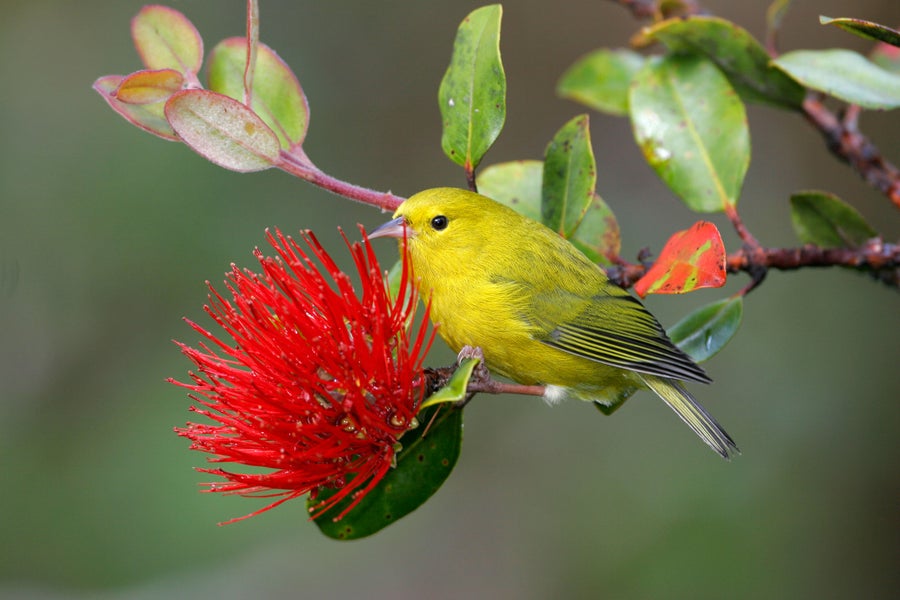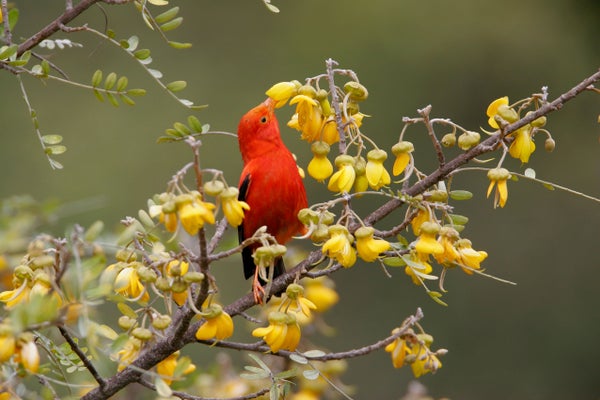Millions of mosquitoes dropped from helicopters could be the greatest hope for Hawaii’s iconic honeycreepers. At least four species of the brightly colored birds could go extinct within the year if no action is taken to save them. “We’re seriously in a race against time at the moment,” says Hanna Mounce, program manager of the Maui Forest Bird Recovery Project.
These small birds evolved on the islands over the course of millions of years and are uniquely adapted to their niche habitat, where they are crucial pollinators for many of Hawaii’s flora. For the people of Hawaii, the honeycreepers are also woven into the cultural fabric, featuring prominently in many legends and providing feathers for traditional garments. More than 50 species of honeycreepers once flitted across the archipelago, but because of introduced predators, habitat destruction and disease, that number has dwindled to only 17. Invasive Culex quinquefasciatus mosquitoes—possibly introduced via water barrels on European ships in the early 19th century—pose a particular threat because they spread the deadly avian malaria parasite.
The honeycreepers that still survive today live high in the mountains, where it is too cool for mosquitoes. Rising temperatures are widening the mosquitoes’ habitat, however, and every year they move higher up the mountain slopes—and kill birds as they go. Four species of honeycreeper—the ʻAkekeʻe (Loxops caeruleirostris) and the ʻAkikiki (Oreomsytis bairdi) on the Hawaiian island of Kauai and the Kiwikiu (Pseudonestor xanthophrys) and ʻĀkohekohe (Palmeria dolei) on Maui—are in particularly dire straits. “We have one more warm year, and we're not going to have any birds left,” Mounce says.
On supporting science journalism
If you're enjoying this article, consider supporting our award-winning journalism by subscribing. By purchasing a subscription you are helping to ensure the future of impactful stories about the discoveries and ideas shaping our world today.
Birds, Not Mosquitoes, a consortium of more than a dozen state, federal, industry and conservation partners, including the Maui Forest Bird Recovery Project, is pinning the birds’ immediate future on the so-called incompatible insect technique (IIT). To date, this mosquito-control method has only been used for mosquito-borne diseases that affect humans, Mounce says. On two islands in China, for example, the technique cut dengue-carrying mosquito populations by 90 percent.

Anianiau (Hemignathus parvus) on a red ohia flower. The bird is found only on Kauai in Alakai swamp and is one of the smallest Hawaiian honeycreepers. Credit: Jack Jeffrey/Photo Resource Hawaii/Alamy Stock Photo
IIT works like this: C. quinquefasciatus mosquitoes, as well as many other arthropods, naturally contain Wolbachia bacteria in their gut. In order to produce offspring together, mating mosquitoes must be infected with the same strain of the bacteria. Birds, Not Mosquitoes’ plan involves releasing male mosquitoes bred by Verily Life Sciences—the life sciences research arm of Alphabet, which also owns Google. These mosquitos will host a different Wolbachia strain than those on Maui. The idea is that the existing female mosquitoes will mate with the male newcomers, but because of their incompatible Wolbachia bacteria, they will not produce viable offspring. If all goes according to plan, the overall mosquito population will plummet.
Birds, Not Mosquitoes initially ran trial studies by releasing 5,000 to 30,000 IIT mosquitoes at a time to study their dispersal and longevity in the wild. The team found that although the introduced mosquitoes lived longer than local ones, they did not move far from the release site. This means that future mosquito releases will need to be spaced closer together. For the next phase beginning in November, the consortium will drop 250,000 treated mosquitoes twice a week over about 3,000 acres in east Maui for a year. They will be contained in mango-sized biodegradable capsules that can each hold about 1,000 mosquitoes.
Success, however, hinges not only on reducing mosquito population numbers but also on ensuring that the new Wolbachia strain does not establish itself in the local mosquito population. If the local mosquitoes become infected primarily with the new Wolbachia, then they will be able to produce offspring with the introduced mosquitoes; that would defeat the goal of the technique and project. To prevent that outcome, the team will set egg traps to check for the new Wolbachia strain. If it is found, the project will stop releases “until there is none of that [strain of] Wolbachia detected in the landscape before we’re able to start again,” Mounce says.
Only female mosquitoes bite, and the project is not releasing any females. If the intervention works, the number of female mosquitoes in the release area will plummet, and the next step will be a landscape-wide release of these doctored mosquitoes. “If there are no female mosquitoes in those areas, then they can’t bite the birds, and there can’t be any malaria transmission,” Mounce says. Mosquitoes are not endemic to the islands and woven into native ecosystems in the same way that, for example, honeycreepers are. Consequently, scientists do not expect their removal to harm the environment.
This approach is not a full solution to the birds' plight. Rather “it’s a Band-Aid to buy time,” says M. Renee Bellinger, a research geneticist at the U.S. Geological Survey, which is one of the consortium’s partners. “We recognize that it’s not a permanent solution. But it is the solution that is available at the moment and has a regulatory pathway that is defined so that we can get the tool on the landscape.” Other concurrent interventions in the U.S. Department of the Interior’s Strategy for Preventing the Extinction of Hawaiian Forest Birds include establishing captive care programs, relocating honeycreepers who belong to the most at-risk species, developing gene drive technology to curb mosquitoes’ ability to transmit the malaria parasite and increasing birds’ malaria resistance.
The IIT plan has a lot of potential, especially in settings such as Hawaii’s forests, where insecticide use would be problematic, says Rosemary Lees, a principal research associate at the Liverpool School of Tropical Medicine in England, who is not involved with the project in Hawaii. “As with all new techniques, it will be critical to monitor the effects of the releases, to collect the operational data critical to evaluate impact and maximize cost-effectiveness and coverage,” she says.
If the IIT intervention fails, it may be necessary to move the honeycreepers out of mosquito-infested areas. Sam ‘Ohu Gon III, a senior scientist and a cultural adviser at the Nature Conservancy, says other islands with higher elevation could provide a refuge to some birds. “Those birds are doomed unless they can be pulled out of that habitat,” he says.
But Gon remains optimistic that the IIT will work, at least as a stopgap. “I’m very hopeful,” he says, “that it can stave off the fact that some of these birds might be extinct in one or two years if we do nothing.”
